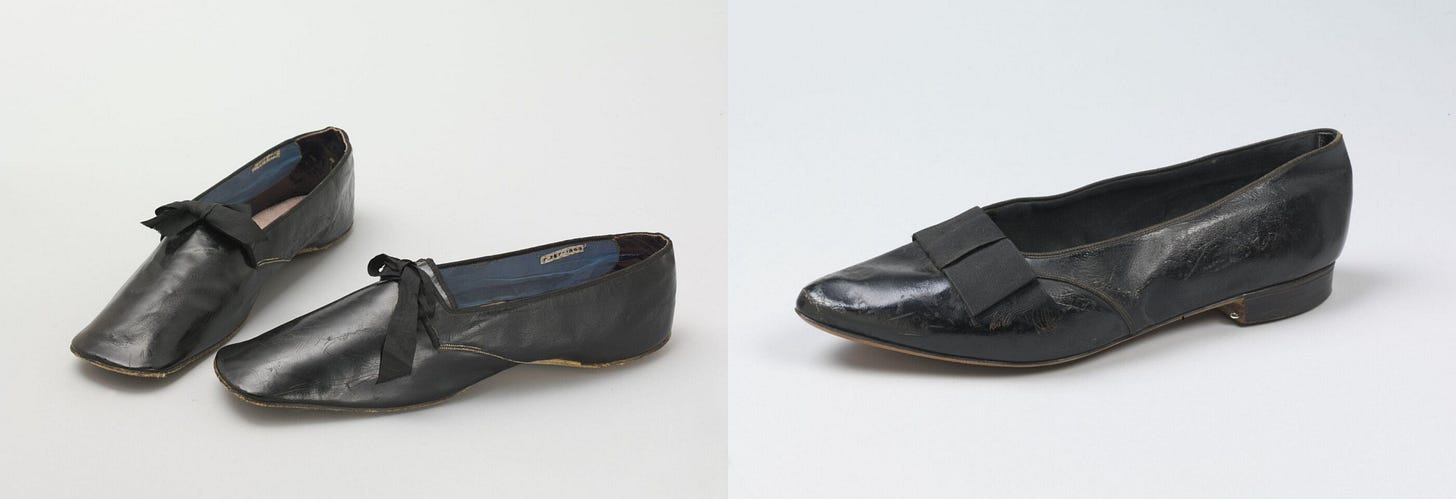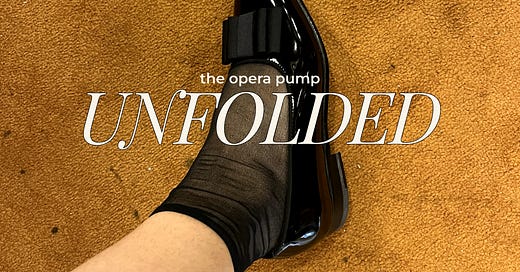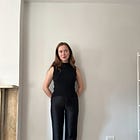Sometime in August I wandered into the Bode Shoe Shoppe on Hester and did something I’m always too nervous to do – I asked to try on their Patent Opera Pumps in a size 36. The man at the counter made a call and a woman ascended from the basement with a crisp box and a pair of black nylon disposable socks in hand. I slipped off my sweaty flats, shrunk to assume as little space as possible in the small store, and tried them. I didn’t think they were comfortable in the slightest— the man at the counter called them ‘Uber shoes’ but I absolutely loved them. I lied and told him I might be back later.
My visit to Bode didn’t end in a purchase but I kept looking back to the photo in my camera roll. I’ve spent the last few months with opera pumps on my mind, scouring secondhand websites and seeing them everywhere– from one of my favorite shoe designers, the Brooklyn-based Suzanne Rae, from Thom Browne (naturally), and this week I saw something akin but closer to a house slipper at Bergdorf’s from Chanel.

My pursuit of a vintage pair would be a hell of a lot easier if they were not a style historically made for men. The opera pump is one of the great menswear items that had remained largely unchanged, both in function and aesthetic, since their introduction into formal attire in the early 17th century until the last forty years. A similar formal pump with a metal buckle had come into fashion in the early 16th century but had fallen out of fashion by the 1760s. In the Regency era, the ‘opera pump’ or ‘court shoe’ once again became the shoe of choice for men of the British aristocracy to wear to formal events with dancing hence ‘opera’.

“Shoes can only be divided into two classes, long quarters and short quarters, that is dress and undress; the dress generally being termed pumps, and always adopted in full evening evening costume, as being absolutely indispensable to etiquette. These should always be made of Spanish leather. In the present fashion, which is very well contrived for showing off the feet, the side of the show should not be above an inch and a half high, and the leather not proceed above the same height over the toe; only, in fact, just sufficient to keep firmly on the foot. The tie should be of broad ribbon, made into a small double bow. Buckles are only used in the army, navy, and marines and should be set with brilliants.”
From The Whole Art of Dress Or The Road to Elegance and Fashion (1830)
The shoe’s current form, a patent laceless slipper with a decorative grosgrain bow is often credited to George “Beau” Brummell – the British Dandy who spent at least two hours per morning washing himself before dressing, famously wore no perfume because he was clean enough not to need it and revolutionized menswear. Brummel’s contribution to the shoe was the introduction of the grosgrain or silk bow (either pinched or straight) across the toe.

Other than Brummell’s softening of the pump’s trimmings, the shoe has remained largely unchanged. Historically, the almost slipper-like shoe is made from a patent leather or shiny well-polished calf skin and is cut from a single piece of leather with a seam down the back of the heel to ensure the foot looks as small and delicate as possible.
One of the functions of the pump, besides being used for dance, is showing off your gorgeous silken socks. The vamp on the opera pump was cut so that the man’s socks would be visible between his trousers and the top of his shoes. Practically, in the woman’s wardrobe, I think they offer a footwear choice that falls somewhere between a ballet flat and a loafer because they are meant to be worn with socks.
By the 1930s, they had mostly fallen out of fashion as men began to opt for ‘less feminine’ styles and styles with laces for formal attire. Some fashion-conscious men still preferred the classic opera pump— they were a staple of Frank Sinatra’s wardrobe for a number of decades.

In the early 1980s, the opera pump made a triumphant return, but this time it was also marketed towards women! Designers including Manolo Blahnik, Bill Blass and Calvin Klein reimagined the shoe for women while transforming something traditionally associated with bourgeois men into a marker of feminine style and power. The 1980s is my favorite decade to talk about because there was such a fascinating convergence of ideas and struggles that defined it: women were entering the workplace in record numbers, luxury consumerism was on the rise, and anxiety about economic status and wealth increased profoundly.
The opera pump was just one of the many fashion trends born from this convergence. In July 1984, Harper’s Bazaar reported,
“With nighttime fashion taking a subtle cue from menswear, it’s only natural that shoes follow suit. This season, black is best, often spiked with glitter or texture. And always flat–the correct proportion for man-tailored styles. Look for inventive takeoffs on the classic man’s dancing pump in patent leather or velvet or oxfords dressed up with pleated silk trim.” (pp. 148)
By 1980, over half of all women in the United States were in the paid workforce and a record-breaking number of them occupied professional positions – from 1970 to 1980, the number of female lawyers surged by 188%. As women negotiated their positions in male-dominated spaces, they adopted and adapted traditionally masculine shapes and pieces—shoulder pads, blazers, suits, oxfords—as tools of empowerment. In doing so, they were redefining what was acceptable for women to wear. The opera shoe is just another example, and one I love, of how fashion responds to—and shapes—moments of social and cultural change.

“Just as the bourgeois male dandy of the early nineteenth century transgressed his allotted role through the impeccable sobriety of the presentation of his dress, asserting his own power and influence over the dominant class, so this feminine dandy propounded the strength of the eighties career woman, and added a vital new ingredient to the puritanical restraint of the dandy: sex appeal.”
Rebecca Arnold in Fashion, Desire and Anxiety: Image and Morality in the Twentieth Century (pp. 106)
I hope you enjoyed today’s musings about the opera pump! Thank you for all of the recent support.
All my love,
Sophia
Updates from The Pleat!
The final gift guide, a last-minute guide to shopping for men, will be released on Wednesday. I apologize for the delay, I have been so sick!









Thank you for this introduction!
Sophia, I thought I'd heard of everything fashionable under the sun, but I did not know about the opera pump! Thank you for this informative and interesting article! I do remember them in the 80s, but I was more about pointy-toed shoes back then.